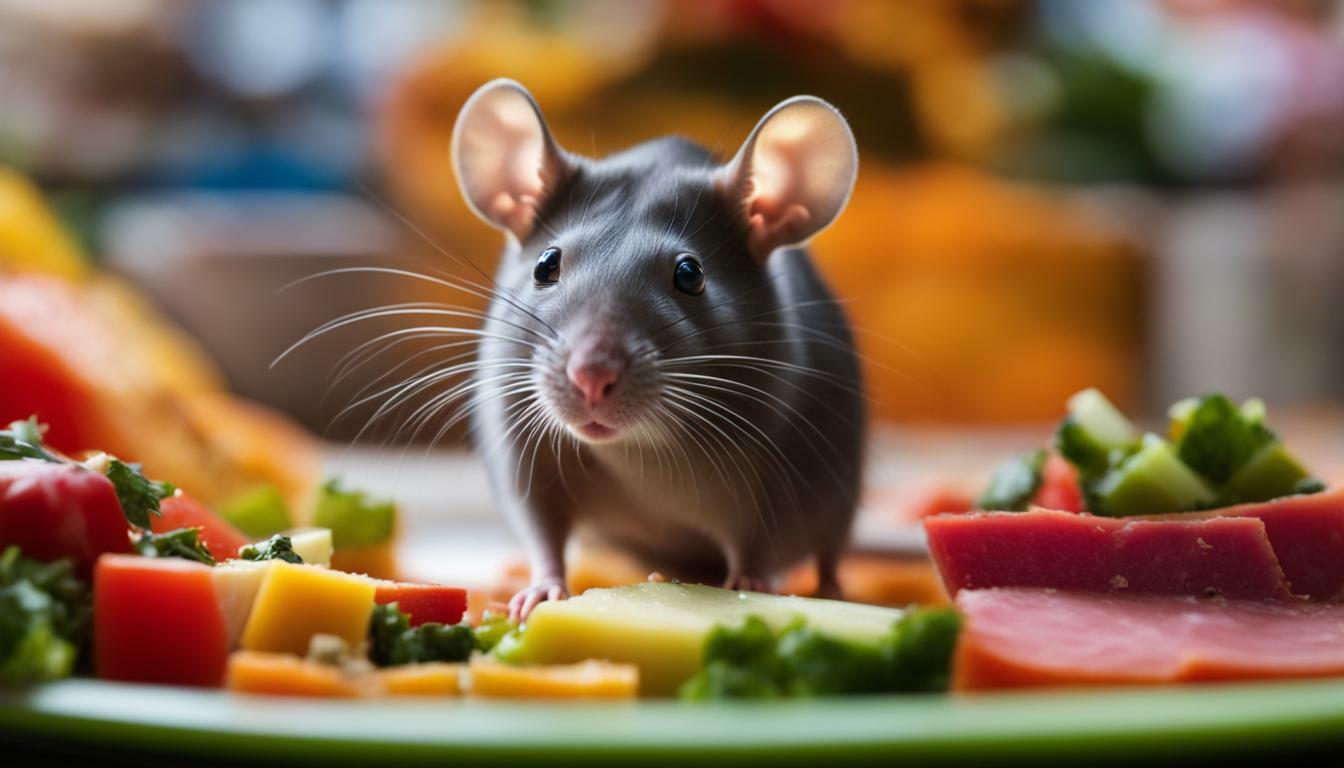If you’re wondering whether rats can eat tuna, it’s important to understand their dietary requirements and any considerations when it comes to their nutrition.
Key Takeaways:
- Rats can eat tuna, but it should only be given in moderation due to high levels of mercury.
- Other fish such as salmon, herring, cod, and shrimp can also be safely fed to rats.
- Fish is a source of essential nutrients like omega-3 fatty acids, but it shouldn’t make up a large part of a rat’s diet.
- Cooking fish before feeding it to rats helps eliminate parasites and bacteria that may be present.
- Fried fish and fish fingers should be given sparingly due to their high calorie and fat content.
Understanding Rat Nutritional Needs
Before deciding if tuna is a suitable food for your pet rat, it’s essential to understand their nutritional needs and dietary requirements. Rats are omnivorous animals and require a balanced diet consisting of proteins, carbohydrates, fats, vitamins, and minerals.
Protein is particularly important for rats as it helps support growth, tissue repair, and overall health. Good sources of protein for rats include lean meats, eggs, and legumes. Carbohydrates, such as grains and fruits, provide rats with energy. Fats are also necessary in small amounts to aid in nutrient absorption and to support healthy skin and coat.
In addition to macronutrients, rats also require certain micronutrients like vitamins and minerals. Rats need vitamin C, which they cannot produce on their own, and can obtain it from fresh fruits and vegetables. They also require minerals like calcium and phosphorus for strong bones and teeth.
The Importance of a Varied Diet
Rats thrive on a varied diet that includes a range of different foods. This helps ensure they receive all the necessary nutrients and prevents them from becoming bored with their diet. Offering a wide variety of rat-friendly foods also helps mimic their natural feeding behaviors in the wild.
“Offering a wide variety of rat-friendly foods not only provides necessary nutrients, but also mental stimulation and enrichment for your pet.”
When it comes to incorporating fish into a rat’s diet, it’s important to do so in moderation. While fish can be a good source of essential nutrients such as omega-3 fatty acids, it should not make up a large portion of their diet. Instead, fish should be offered as a treat or a supplement to their regular food. Other fish options besides tuna, such as salmon, herring, cod, and shrimp, can be safely fed to rats.
| Recommended Rat-Friendly Fish | Nutritional Benefits |
|---|---|
| Salmon | High in omega-3 fatty acids, which support brain health and reduce inflammation |
| Herring | Rich in proteins and good fats, beneficial for overall health |
| Cod | Contains essential vitamins and minerals, including vitamin B12 and selenium |
| Shrimp | Low in calories and high in protein, a great addition to a rat’s diet in small amounts |
When feeding fish to rats, it’s important to cook it thoroughly to eliminate any potential parasites or bacteria. This helps ensure the safety of the fish before it is consumed by your pet. Fried fish and fish fingers should only be given in very small amounts due to their high calorie and fat content. These should be considered as occasional treats, rather than a regular part of their diet.
Remember, maintaining a balanced and varied diet is crucial for the overall health and well-being of your pet rat. If you have any concerns or questions about their diet, it’s always best to consult with a veterinarian who specializes in small animal care.
The Role of Fish in a Rat’s Diet
Fish can be a beneficial addition to a rat’s diet, providing essential nutrients, such as omega-3 fatty acids. Let’s delve into the role of fish and explore safe options for your pet rat.
Rats have specific nutritional needs that must be met to keep them healthy. While their main diet consists of high-quality rat pellets, incorporating fish into their diet can offer additional health benefits. Fish is a good source of protein, vitamins, and minerals that contribute to a balanced diet for your pet rat.
When it comes to introducing fish into your rat’s diet, it is important to choose safe options that are suitable for their consumption. Some safe fish choices for rats include salmon, herring, cod, and shrimp. These fish are nutritious and can be fed to rats in moderation as part of a varied diet.
| Safe Fish Choices for Rats | Nutritional Benefits |
|---|---|
| Salmon | Excellent source of omega-3 fatty acids |
| Herring | Rich in essential vitamins, such as vitamin D and vitamin B12 |
| Cod | Good source of high-quality protein |
| Shrimp | Contains essential minerals like selenium and zinc |
It is important to note that fish should not constitute a large part of a rat’s diet. While fish can offer nutritional benefits, it should be given in moderation as part of a balanced meal plan. Rats have diverse dietary needs, and a varied diet that includes a range of rat-friendly foods will ensure they receive all the necessary nutrients for optimal health.
Before serving fish to your rat, it is crucial to cook it thoroughly. Cooking the fish helps eliminate any potential parasites or bacteria that may be present and ensures the safety of your pet. Fried fish and fish fingers should only be given sparingly due to their high calorie and fat content, which can lead to weight gain and other health issues.
Can Rats Eat Tuna?
Now let’s answer the question: can rats safely consume tuna? While rats can eat tuna, it should be given in moderation due to certain risks and considerations. Tuna contains high levels of mercury, which can be harmful to rats if consumed in large quantities. Mercury is a toxic metal that can accumulate in an animal’s body over time, leading to health problems.
“Mercury is a toxic metal that can accumulate in an animal’s body over time, leading to health problems.”
According to a study by the Environmental Protection Agency (EPA), smaller fish species, such as tuna, tend to have higher levels of mercury compared to larger fish. The EPA advises limiting the consumption of tuna for both humans and animals to avoid mercury poisoning. It is recommended to offer small amounts of tuna as an occasional treat rather than a regular part of a rat’s diet.
“It is recommended to offer small amounts of tuna as an occasional treat rather than a regular part of a rat’s diet.”
When it comes to feeding fish to rats, there are other options that can provide similar nutritional benefits without the high mercury content. Salmon, herring, cod, and shrimp are all safe and nutritious choices for rats. These fish contain essential nutrients, such as omega-3 fatty acids, which are beneficial for a rat’s overall health. Including a variety of fish in a rat’s diet can help provide a balanced and diverse nutritional profile.
“Including a variety of fish in a rat’s diet can help provide a balanced and diverse nutritional profile.”
It is essential to cook fish before feeding it to rats to eliminate any potential parasites or bacteria. Cooking the fish thoroughly ensures that it is safe for consumption and reduces the risk of foodborne illnesses. Additionally, it is important to note that fried fish and fish fingers should be offered sparingly due to their high calorie and fat content. These foods should be given as occasional treats, if at all, to maintain a healthy weight for your rat.
“Fried fish and fish fingers should be offered sparingly due to their high calorie and fat content.”
| Can Rats Eat Tuna? | Safe Fish Choices for Rats | Cooking Fish for Rat Consumption | Fried Fish and Fish Fingers for Rats |
|---|---|---|---|
| Yes, but in moderation | Salmon, herring, cod, shrimp | Thoroughly cook before feeding | Sparingly, due to high calorie and fat content |
Other Safe Fish Choices for Rats
If you’re looking to diversify your rat’s diet with fish, there are several other options besides tuna that can be safely included. Let’s explore some of these choices.
Salmon: Salmon is a nutritious and delicious fish that rats enjoy. It is rich in omega-3 fatty acids, which promote brain health and support a strong immune system. Feeding your rats cooked salmon in small portions can be a great way to introduce variety into their diet.
| Fish | Nutritional Benefits |
|---|---|
| Salmon | Rich in omega-3 fatty acids, supports brain health and immune system |
| Herring | Good source of protein, vitamins, and minerals |
| Cod | High in protein, low in fat, easily digestible |
| Shrimp | Rich in protein, vitamin D, and omega-3 fatty acids |
Herring: Another safe fish choice for rats is herring. It is packed with essential nutrients, including protein, vitamins, and minerals. Adding cooked herring to your rat’s diet can provide them with a well-rounded source of nutrition.
- Cod: This white fish is high in protein and low in fat, making it a healthy choice for rats. It is easily digestible and can be a great addition to their diet.
- Shrimp: Rats can also enjoy cooked shrimp in moderation. Shrimp is a good source of protein, vitamin D, and omega-3 fatty acids, which are beneficial for their overall health.
“Feeding your rats a variety of fish can help ensure they receive a balanced diet.”
Feeding your rats a variety of fish can help ensure they receive a balanced diet. While tuna can be given occasionally, due to its high mercury content, it should not be a staple food for rats. Instead, consider incorporating other safe fish choices such as salmon, herring, cod, and shrimp into their meals. Remember to cook the fish to eliminate any potential parasites or bacteria, and offer fried fish and fish fingers in very small amounts due to their high calorie and fat content.
Summary:
Rats can eat tuna, but it should be given in moderation due to its high mercury levels. It is important to diversify their diet with other safe fish choices such as salmon, herring, cod, and shrimp to provide a well-rounded source of nutrition. Cook the fish before feeding it to your rats to ensure their safety, and be cautious with high-calorie fried fish and fish fingers. By offering a balanced diet that includes a variety of fish, you can help promote the health and well-being of your pet rats.
Cooking Fish for Rat Consumption
It’s crucial to cook fish properly before offering it to rats to ensure their safety and prevent the transmission of parasites or bacteria. Here’s why this step is important:
- Cooking fish kills parasites and bacteria: Raw fish can contain parasites such as tapeworms and bacteria like Salmonella and Listeria. These can be harmful to rats and may lead to digestive issues or even serious infections. By thoroughly cooking the fish, you effectively eliminate these potential risks, making it safe for your pet rat to consume.
- Increased digestibility: Cooking fish makes it easier for rats to digest. The heat breaks down the proteins and fats, making them more accessible to the rat’s digestive system. This improves nutrient absorption and reduces the likelihood of stomach upset or indigestion.
- Enhanced flavor and texture: Cooking fish enhances its flavor and texture, making it more palatable for rats. This can help entice picky eaters to try new foods and ensure they receive a well-balanced diet. Whether you choose to bake, steam, or grill the fish, the cooked texture is typically softer and easier for rats to chew and enjoy.
Remember that when cooking fish for your rat, it’s best to avoid adding seasonings, oils, or sauces. Stick to plain, unseasoned preparations to ensure that your rat receives the most natural and nutritious form of the fish.
| Safe Fish Choices for Rats | Feeding Frequency |
|---|---|
| Salmon | Once or twice a week |
| Herring | Once or twice a week |
| Cod | Once a week |
| Shrimp | A few times a month |
While cooking fish for your rat can take a little extra time and effort, it’s an essential step in ensuring their health and well-being. By cooking the fish thoroughly, you eliminate potential risks, improve digestibility, and enhance the flavor and texture. Remember to offer cooked fish in moderation as part of a varied and balanced diet, and your rat will enjoy the nutritional benefits that fish can provide.
Fried Fish and Fish Fingers for Rats
While some rats may find fried fish or fish fingers enticing, it’s important to exercise caution when offering these foods due to their high calorie and fat content. Rats have different nutritional needs than humans, and a diet high in calories and fat can lead to obesity and other health issues.
It is recommended to provide fried fish and fish fingers to rats as an occasional treat in very small amounts. These foods should not make up a significant part of a rat’s regular diet. Rats require a balanced diet that consists primarily of fresh fruits and vegetables, supplemented with a small amount of protein, such as lean meats or insects.
“Rats are opportunistic eaters, and they may readily consume foods that are not suitable for their health,” says Dr. Jane Wilson, a small animal veterinarian.
“While fried fish and fish fingers may be tasty to rats, they can contribute to weight gain and can potentially lead to other health problems. It’s important for rat owners to provide a varied and balanced diet to ensure their pets’ well-being.”
Dr. Wilson further advises rat owners to consult with a veterinarian to ensure their rats are receiving the appropriate diet for their specific needs.
| Food | Calories per serving | Fat per serving |
|---|---|---|
| Fried Fish | Approximately 250 calories | Approximately 15 grams |
| Fish Fingers | Approximately 200 calories | Approximately 9 grams |
As the table shows, both fried fish and fish fingers contain a considerable amount of calories and fat that can easily surpass a rat’s daily nutritional requirements. It’s essential to prioritize a balanced and appropriate diet for rats to maintain their overall health and well-being.
Moderation is Key
When it comes to feeding tuna or any other fish to rats, moderation is key. While rats can safely consume tuna, it should only be given in small amounts due to the high levels of mercury found in this fish. Mercury can be toxic to rats if consumed in large quantities, so it’s important to limit their intake to prevent any potential harm.
To ensure your pet rat’s nutritional balance, consider incorporating a variety of fish options into their diet. Salmon, herring, cod, and shrimp are all safe choices that provide essential nutrients, including omega-3 fatty acids. These nutrients are beneficial for rats and promote overall health.
When preparing fish for your rat, it is advisable to cook it thoroughly. Cooking helps eliminate any parasites or bacteria that may be present, ensuring the safety of the food. By cooking the fish, you can provide your rat with a safe and healthy meal.
While fish can be a valuable addition to a rat’s diet, it should not make up a large portion of their daily food intake. Rats require a diverse diet that includes a variety of fruits, vegetables, grains, and protein sources. Fish should be offered as a occasional treat or supplement to their main diet.
Table: Recommended Fish Choices for Rats
| Fish | Benefits |
|---|---|
| Salmon | Rich in omega-3 fatty acids |
| Herring | Good source of essential nutrients |
| Cod | Low in mercury and high in protein |
| Shrimp | Contains beneficial minerals |
Remember, when it comes to feeding tuna or any other fish to your pet rat, moderation is key. By following these guidelines and providing a balanced diet, you can ensure your furry friend stays healthy and happy.
Conclusion
In conclusion, while rats can eat tuna, it should only be given in moderation due to its high mercury levels. Other fish options, such as salmon, herring, cod, and shrimp, can also be safely included in a rat’s diet. These fish provide essential nutrients, including omega-3 fatty acids, which are beneficial for rats.
When feeding fish to your pet rat, it is important to cook it thoroughly to eliminate any potential parasites or bacteria that may be present. Cooking the fish ensures the safety and well-being of your rat.
It is advisable to avoid feeding fried fish or fish fingers to rats. These foods are high in calories and fat, which can lead to weight gain and other health issues in rats. It is best to prioritize the nutritional needs of your pet rat and provide a balanced diet.
Remember, always consult with a veterinarian before making any significant changes to your rat’s diet. They can provide personalized advice based on your specific rat’s needs and health condition.
FAQ
Can rats eat tuna?
Yes, rats can eat tuna, but it should only be given in moderation due to its high mercury content.
What other fish can be safely fed to rats?
Rats can also safely consume salmon, herring, cod, and shrimp in moderation.
Is fish an important part of a rat’s diet?
Fish can provide essential nutrients, including omega-3 fatty acids, but it should not be a large part of a rat’s diet.
Should fish be cooked before feeding it to rats?
Yes, it is advisable to cook fish before feeding it to rats to eliminate any parasites or bacteria that may be present.
Can rats eat fried fish or fish fingers?
Fried fish and fish fingers should be given in very small amounts due to their high calorie and fat content.
How much and how often should rats be given tuna or other fish?
It is important to offer tuna or other fish in moderation. Guidelines on how much and how often to feed fish to rats can vary, so it is best to consult with a veterinarian for specific recommendations.




